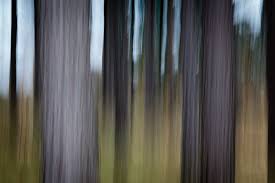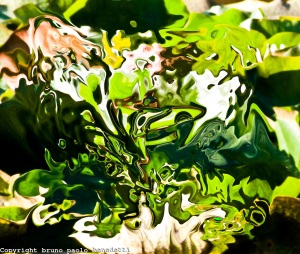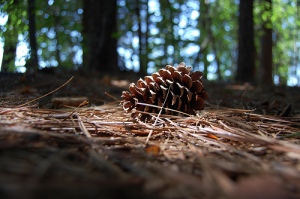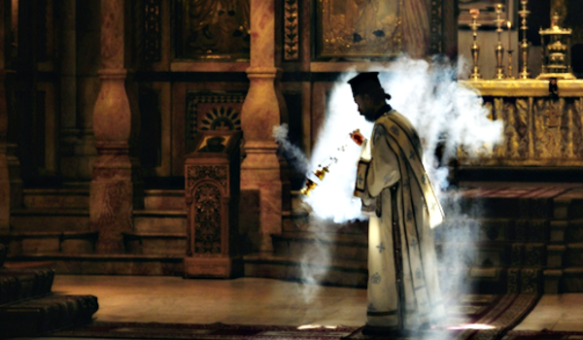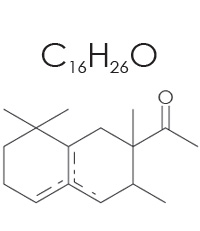Everyone has a few perfume houses that they have a soft spot for, and generally like. Profumum (or Profumum Roma) is one of those for me, a brand whose focus on doing one thing in the richest way possible appeals to me very much. I like their aesthetic, even when some of their fragrances don’t suit my personal tastes or style. In fact, there has only been one Profumum scent that I found to be a massive disappointment. Well, now there are two.
Sorriso (the Italian word for “smile”) is the newest fragrance from the Italian niche perfume house, an eau de parfum that was released in late 2013. Profumum‘s website describes the perfume very simply:
The taste of life and the enthusiasm of
an embrace will donate her marvalous smile.[Notes:] Bitter chocolate, bitter orange, vanilla, tropical woods
Sorriso opens on my skin with a concentrated, somewhat boozy, intensely sweetened vanilla note which is overtaken seconds later by dusty cocoa powder, a hint of musky oil, and a subtle woodiness. As the dry cocoa asserts its supremacy, the vanilla melts into it, losing its boozy undertone at the same time and turning slightly drier.
The bouquet in the first five minutes is nothing more than that of a swirled chocolate and vanilla milkshake. It’s deep, smooth, rich, and decadent. The chocolate is lovely, feeling simultaneously like the powdered, dusty, semi-sweet kind and a milk-based hot chocolate. There is absolutely no orange that appears on my skin, but there is a faint whisper of something a bit like dried roses wafting about for three or four minutes. The less pleasant aspect is the hint of a musky oiliness.It smells a lot like a sweetened, but very generic, inexpensive oil before eventually turning into the smell of a common, drugstore Shea butter.
Sorriso barely changes, except for the growing prominence of the sweetened, musky oil. Twenty minutes in, Sorriso is a simple chocolate milkshake scent whose every molecule is infused with vanilla, all enveloped in a musky, wholly artificial-smelling, common oiliness. Sorriso is sweet, yes, but it is also a relatively dry sweetness. This is not a syrupy or diabetically gooey gourmand on my skin. It is also a very soft scent that is surprisingly thin in feel for a Profumum. It lacks the heft, viscosity and potency of the other fragrances in the line, particularly Ambra Aurea, Dulcis in Fundo, Patchouly, and Arso. It is also much thinner in feel than Fiore d’Ambre, though it is richer than the unpleasant, wholly synthetic Santalum. Sorriso’s projection is as soft as its weight, wafting out 2 inches at best from my skin with 3 massive smears.
There is a woody note underlying Sorriso that is hard to place. It doesn’t smell like Australian Sandalwood or any of its generic, beige, synthetic substitutes. If I had to take a guess, I’d say it smells more like Cashmeran. I own a hand cream from Bath & Body Work‘s True Blue Spa Line called “Shea Cashmere,” and it smells a lot like Sorriso, minus the cocoa powder. None of these comparison to common products — whether drugstore Shea butter or a B&BW cream — is meant as a particular compliment, by the way. Not at Profumum’s prices.
Sorriso stays on its uninspired trajectory for eons, taking Profumum’s general singularity to a new level. I always say that there is nothing wrong with linearity if you like the notes, but the issue here is that they are so unimpressive and mediocre. The other problem is that, even by Profumum’s soliflore standards, its scents usually have more variegated layers or nuances than Sorriso. There are changes in such Profumum scents as Arso, Ambra Aurea, Acqua di Sale, Olibanum, or the like, even if they can occasionally be subtle or a question of degree. Sorriso makes Ambra Aurea look like one of Serge Lutens’ morphing, complex, twisting, bell jar masterpieces. Hell, it makes the entire rest of the Profumum line look like something out of an Amouage catalog, particularly in terms of quality.
Sorrio’s scent is a fatally boring flat-line, with the most noticeable changes being to the weight, body, and sillage. It takes a mere hour for Sorriso’s notes to fold onto themselves, and for the fragrance to turn into a relatively thin choco-musk bouquet with vanilla, a hint of woodiness, and musky, Shea-like butter. By the end of the second hour, it’s soft and not particularly deep, though it’s not exactly gauzy either. At the end of the 4th hour, Sorriso is a skin scent, though you can still easily detect the unchanging, mediocre bouquet if you sniff it up close.
The one, solitary change is the sudden appearance of the orange towards the middle of the 7th hour. Its unexpected arrival was almost shocking in the novelty of having something different finally happen! Unfortunately, the orange was both minor, hazy, and muted, doing nothing more than to underscore the continuing impression of Sorriso as a scent whose main characteristic from afar is dry-sweetness. Up close, if you sniff really hard with your nose on your skin, the perfume’s primary essence remains unchanged: a nebulous, sweetened, choco-musk bouquet, though even the cocoa is massively faded by now. In any event, the orange only lasted 20 minutes on my skin, so it doesn’t really matter anyway.
All too soon, Sorriso devolves into nothing more than an abstract, amorphous smear of musky, woody sweetness. There it remains until its very end, 9.75 hours from the start. I was thoroughly unimpressed with almost all of it, except for the opening two minutes which were relatively pleasant but still nothing to write home about. (Plus, the longevity was a big disappointment as compared to the rest of the Profumum line.)
I actually tested Sorriso twice, and my first experience was extremely different. These next words may not mean anything to anyone who didn’t live through the early 1980s, but I think it will definitely ring a bell for those who did: Bain de Soleil! At the time, my family and I were living in New York during the school year, and the big thing in America at the time were the commercials and print adverts for the suntan oil. The television commercials were especially catchy with their refrain, “Bain de Sole-ay/ For the St. Trop-ay/Tan.” It always amused me, because I never saw anyone IN St. Tropez or the South of France actually using the stuff. But I loved the commercials and how they mentally took me away from a place (and school) that I did not enjoy. So, I bought the damn thing, and rather liked the smell, primarily because it was nothing like the greasy, heavy, coconut aroma of the Hawaiian Tropic oils. Instead, the Bain de Soleil of my memory smelled of musky, sweetened Shea oil, with a touch of vanilla, some indistinct dryness, and a vague sense of a dried, abstract brown…. something. Dried fruits? Who knows? It was all so nebulous, except for the sweetened oil.
When I applied only a small quantity of Profumum’s Sorriso, the aroma on my skin smelled exactly like my memory of Bain de Soleil: sweetened, musky oil with a Shea oil-like aroma that was dry and infused with some intangible dried fruitiness. Bain de Soleil wasn’t at all tropical like usual suntan oils, and neither is Sorriso. But the similarities left me rather astounded for hours on end, transporting me back in time. With the small dosage, the cocoa was virtually nonexistent on my skin except as some sort of dusky, dusty…. something. The main aroma was… well, Bain de Soleil. There is no other way I can describe its nebulous, amorphous oddness. I couldn’t get over it. So, I was quite relieved when I tested Sorriso a second time around using the 3 massive smears, and detected chocolate from the start. Unfortunately, as I’ve already explained, it all went downhill from there.
My overall reaction to Sorriso isn’t boredom. It is more along the lines of, “Seriously??! This is it?!” My main problem is that Sorriso really lacked the luxuriousness that is Profumum’s signature, as well as the brand’s concentrated, hefty, rich elegance. Sorriso felt generic, cheap, and wholly pedestrian. I couldn’t help comparing it to Profumum’s gourmand take on vanilla, Dulcis in Fundo, which is one of the richest, most over-the-top vanillas that I’ve encountered, even if it is too much for my personal tastes. Sorriso does not do the same for chocolate.
In fact, I consistently found myself pondering whether the massively inexpensive Choco Musk oil from Al Rehab would be deeper and heavier. I haven’t tried it, but I’ve heard talk of Choco Musk, and I bet it is the same as (if not better than) Sorriso, especially for the price. It only costs $3.75 for 6ml on Amazon. Sorriso, in contrast, costs $265 which is either a rare exception to the usual Profumum price, or part of the company’s new, anticipated price hike for the line which was supposed to occur either sometime this month or in March. I’m going to order the Choco Musk just to compare, because Sorriso? Bah.
The blog reviews for Sorriso thus far are either ambivalent or negative. For Jessica on Now Smell This, the main problem seemed to be the longevity, though it doesn’t scream enthusiasm to me as a whole. Her short review states:
Just as Vanitas feels like a smoother, better constructed version of Confetto (minus the almond), Sorriso is an improvement on Battito d’Ali’s theme. It doesn’t have Battito d’Ali’s strange sharp after-taste; the vanilla helps to encourage the chocolate’s sweetness, without turning it into cake frosting, and the “bitter orange” note is meshed with a subtle anise and some mysterious additional aromatic-herbal note. The main problem with this fragrance, for me, is its lack of longevity — if Sorriso is a smile, it’s a fleeting one. And, as for much of the line, the price seems high for compositions that aren’t particularly innovative or complex. I like a guilty-pleasure gourmand as much as anyone, but to me, it shouldn’t cost more than a perfume from Editions de Parfums or Serge Lutens.
The Non-Blonde couldn’t stand Sorriso, though she had no longevity problems at all. She wrote, in part:
I was very excited about Sorriso, the new fragrance from Profumum. […] It sounds like a gourmand heaven for my chocolate-loving heart. The problem started right away: Sorriso greeted me with a harsh and loud saccharine confection that reminded me of dairy-free whipped desserts. It’s frothy, sweet, vanillic, and utterly artificial. The worst part? On my skin this perfume smells cheap.
No matter how much I tried, the chocolate Profumum had promised never arrived for me (neither did the bitter orange). I tested Sorriso in the cold air and while working out. No chocolate, but … I kept getting this piercing not-really vanilla foam. I did not enjoy the process. The husband’s skin was not much help, either. Sorriso on him was a bit fatty with a hint of a coconut-like suntan lotion. Not real coconut, just that manufactured oiliness. No chocolate either.
As is often the case with overly sweet perfumes that trigger my Do.Not.Want reflex, Sorriso has the tenacity and determination of Her Majesty The Queen. […] I enjoy several Profumum creations, mostly the masculine woody ones. I guess Sorriso will join Dulcis in Fundo and Acqua e Zucchero, two other hugely popular Profumum gourmands that I simply can’t stand.
I smirked when I read about her husband’s experience and the fatty suntain oil. (I wonder if he’s ever smelled Bain de Soleil?) It does seem as though the Non-Blonde herself doesn’t like serious, heavy gourmands, though her issue here was clearly more with the total domination of a synthetic-smelling vanilla than with anything else. I don’t like hardcore gourmands, either, but Sorriso wasn’t one on my skin. It wasn’t anything, frankly, except wishy-washy and utterly mediocre, at best. If it had at least tried to be like Dulcis in Fundo, I would respect it for meeting the Profumum standard, but it doesn’t. In fact, Sorriso falls far short of it, in my opinion. And we won’t even start on how over-priced it is for what you’re getting!
On Fragrantica, there are only two reviews for Sorriso thus far, and they are widely divergent. The first is positive:
If Dulcis in Fundo can be called a magnificent orange dreamsicle, then Sorriso can sit beside it in the freezer as a magnificent Fudgesicle. [¶] It’s a prominent, yet soft, cocoa on a creamy vanilla base, tempered by a touch of popsicle stick. I get no orange here (certainly nothing like Dulcis in Fundo).
I find it gentle and appealing, something I would be happy to wear. I would be tempted to go for a full bottle if I had not already invested in Gourmand Coquin. Gourmand Coquin is *in your face* divine, while Sorriso is more reserved. They don’t serve quite the same purpose, but it would take a budget bigger than mine to justify owning both.
The second review is from “Alfarom,” a poster with whom I often seem to share the same opinion of things. In fact, his second sentence is verbatim what I wrote in my notes a few times:
What? Are they serious? Considering the name of the fragrance, I don’t think so. Italian word *Sorriso* stands for english word *Smile* but I think at Profumum they understimated the hilarious power of this stuff. It would have probably better be labelled as *Laugh* or, considering how juvenile this stuff smells, even *LOL*.
A cheap and vile concoction of cacao and hyper-sweet vanilla with a tad of the sweetest sandalwood thrown in. It would suck even in the I Tesori d’Oriente’s range. Meh!…with a laugh.
Rating: 3/10.
I quite agree. “Are they serious?” sums it up perfectly.










